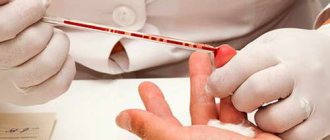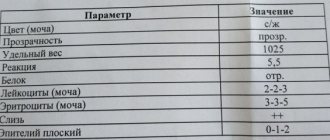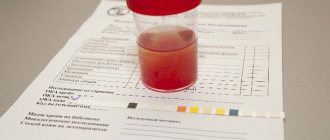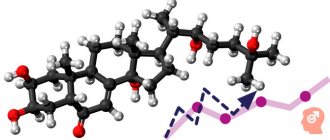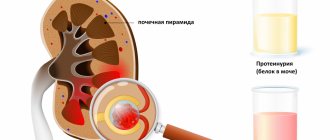November 14, 2018
All tests in 1 day
One type of laboratory diagnosis is a general blood test. It allows you to identify a large number of pathologies, such as malignant tumors, infectious, inflammatory diseases, etc. It can also be used to evaluate the effectiveness of patient treatment. After all, a general blood test can tell a lot about the state of the body.
Only specialized doctors can correctly decipher a general blood test. Therefore, without the appropriate medical knowledge, you should not even try to do it yourself. But it will not be superfluous to know by what indicators the blood is analyzed, as well as the norms of the test result. You will find this information in our article.
Table 1
| Index | Designation | In men | Among women |
| Red blood cells (x 1012/l) | R.B.C. | 4-5,1 | 3,7-4,7 |
| Average erythrocyte volume (fl or µm3) | MCV | 80-94 | 81-99 |
| Erythrocyte sedimentation rate (mm/h) | ESR | 2-15 | 2-10 |
| Anisocytosis of erythrocytes (%) | RDW | 11,5-14,5 | 11,5-14,5 |
| Hemoglobin (g/l) | HGB | 130-160 | 120-140 |
| Average hemoglobin level in erythrocyte (pg) | MCH | 27-31 | 27-31 |
| Average erythrocyte hemoglobin concentration (%) | MCHC | 33-37 | 33-37 |
| Color index | CPU | 0,9-1,1 | 0,9-1,1 |
| Hematocrit (%) | HCT | 40-48 | 36-42 |
| Platelets (x 109/l) | PLT | 180-320 | 180-320 |
| Average platelet volume (fl or µm3) | MPV | 7-11 | 7-11 |
| Reticulocytes (%) | RET | 0,5-1,2 | 0,5-1,2 |
| Leukocytes (x 109/l) | WBC | 4-9 | 4-9 |
Analysis for leukocytes in the blood
To determine the level of leukocytes, a classic general blood test is used - the most popular test, without which not a single examination can be done.
In addition to identifying five types of white cells, the analysis reveals the number and characteristics of red blood cells, hemoglobin, platelets and other blood components.
It is also necessary in the diagnosis of anemia, diagnosis and treatment of inflammatory processes, as an element of preventive examination, in the diagnosis of a diverse range of diseases and for monitoring treatment.
table 2
| Index | x 109/l | % |
| Band neutrophils | 0,04-0,3 | 1-6 |
| Segmented neutrophils | 2-5,5 | 45-72 |
| Basophils | up to 0.065 | up to 1 |
| Eosinophils | 0,02-0,3 | 0,5-5 |
| Lymphocytes | 1,2-3 | 19-37 |
| Monocytes | 0,09-0,6 | 3-11 |
The results of a general blood test (Table 1) show many indicators. Let's consider the main ones:
- RBC – total number of red blood cells (erythrocytes). The pathological increase in these cells is associated with impaired hematopoiesis. A decrease in red blood cells is usually a consequence of anemia, hemolysis and blood loss.
- HGB stands for hemoglobin, which is a protein containing iron. It transports oxygen to tissues, and carbon dioxide from them, and also maintains acid-base balance. A decrease in hemoglobin most often occurs due to anemia.
- HCT – hematocrit. It is defined as the ratio between the red blood cells that have settled to the bottom after taking the test and the total blood volume. An increase in this indicator indicates polyuria, erythrocytosis or erythremia. A decrease in hematocrit level occurs with anemia and an increase in circulating blood volume.
- PLT – platelets. These cells are responsible for blood clotting. If their number decreases, then the cause may be viral diseases, bone marrow lesions, bacterial infections and other pathologies. An increase in the number of platelets is caused by a wide variety of ailments: from joint diseases to cancer.
- CPU – color indicator. It determines the saturation of red blood cells with hemoglobin. If it is insufficient, this may indicate iron deficiency anemia, anemia or lead poisoning. When CP rises above normal, the cause is oncology, gastric polyposis and deficiency of vitamins B9 and B12.
- Erythrocyte indices: MCV - average volume of erythrocytes, used to determine water-salt balance and type of anemia;
- RDW is the degree of red blood cell diversity, which determines how different cells differ from each other in volume;
- MCH – average hemoglobin content in erythrocyte; this criterion is considered analogous to the color indicator;
- MCHC – average concentration and content of hemoglobin in red blood cells; this indicator is calculated taking into account the level of hematocrit and hemoglobin.
Now let's move on to the leukocyte formula (Table 2). It determines the percentage of different types of white blood cells in the blood, that is, the relative content of each type of white cell. What is this formula for? It is very important because with any changes in the body, the percentage of certain types of white cells in the blood decreases or increases. This is associated with a decrease or increase in other types. Based on the information obtained from the leukocyte formula, one can judge the course of a particular pathology, the occurrence of complications, and also more accurately predict the outcome of the disease.
What deviations in the UAC may mean
For diagnosis, both a current blood test and previous studies are important to track changes. Let's consider what deviations in indicators can mean:
- Red blood cells. Exceeding the value is accompanied by insufficient oxygen supply, dehydration, acquired heart disease, and impaired adrenal function. The level may be lower than normal due to blood loss, iron deficiency anemia, in the second half of pregnancy, and with chronic infectious diseases.
- Leukocytes. Leukocytosis (exceeding the norm) can be caused by physiological characteristics or pathology. In the first case, the causes are: pregnancy, intense physical/psycho-emotional overload, hypothermia/overheating. Inflammatory and oncological diseases, poisoning and allergic reactions are manifested by pathological leukocytosis. With leukemia, bone marrow hypoplasia, liver damage, measles, lymphogranulomatosis, autoimmune diseases, a decrease in leukocytes will be detected.
- Platelets. The amount decreases with leukemia, AIDS, poisoning, bone marrow damage, prolonged therapy with hormones or antibiotics. The indicator goes beyond the normal range with inflammation of the rectal mucosa, osteomyelitis, joint diseases, cancerous lesions, and in the postoperative period.
- Hemoglobin level. Exceeding the norm occurs against the background of an increased platelet count, impaired blood clotting function, after a gastrointestinal disorder, or with an overdose of medications for anemia. Low HGB gives the right to suspect the presence of internal bleeding, kidney dysfunction, malignant neoplasms, and bone marrow damage.
- Erythrocyte indices (MCV, MCH, MCHC). The indicators give an idea of the state of red blood cells and their functionality. MCV is the average volume of one red blood cell; it increases with diseases of the liver and hematopoietic system, lack of folic acid and vitamin B12. Decreased in some types of anemia, hyperthyroidism, hemoglobinopathy. MCH shows the average hemoglobin content in one red blood cell. Analogous to color index. MCHC – average concentration of red blood pigment. The interpretation is carried out taking into account other indices.
- Hematocrit level. Allows you to assess the severity of anemia associated with iron deficiency. Exceeding the norm indicates dehydration, extensive burns, and inflammation of the peritoneum. A low figure gives the right to suspect pathologies of the heart and vascular system, kidney disease, blood disease, extensive blood loss, malaria, and poisoning.
- Reticulocyte count. Exceeding the norm is observed in case of blood loss, poisoning, taking certain medications, during the recovery period after treatment of cancer, diseases of the hematopoietic system, metastases in the bone marrow. A decrease in the number of young red blood cells is caused by: anemia, kidney disease, chronic infections, bone marrow tumors, blood pathologies, myxedema of the thyroid gland, chemotherapy, deficiency of folic acid and vitamin B12.
- ESR. Decreases in heart pathologies, joint diseases, anaphylactic shock. Exceeding the norm is observed during pregnancy, anemia, severe poisoning, exacerbations of chronic diseases, and inflammatory processes in the body.
- Color. Hyperchromia (exceeding the norm) indicates a deficiency of cyanocobalamin, possible polyps in the stomach, various malignant tumors, and a lack of vitamin B9. Hypochromia (decreased color index) indicates anemia or lead poisoning. With normochromia, the doctor looks at the values of other, more informative indicators.
Do I need to take a clinical blood test and a general urine test before vaccinations?
In addition to medical examination and acute illness, the third reason for taking a clinical blood test and a general urine test is the upcoming vaccination. If you or your child last had blood and urine tests a year ago and everything was fine, this is not a reason to refuse them.
Vaccination is a rather serious intervention in the body, requiring 100% confidence that the patient is healthy. This is why I always recommend that my patients preparing for vaccinations take a clinical blood test and a general urine test at least 30 days before vaccination, but the closer, of course, the better.
Preparing for analysis
The study is carried out in the morning on an empty stomach, since food intake causes an increase in the number of neutrophils in the blood. Dinner on the eve of the test is allowed no later than eight o'clock in the evening. 2 days before the study, the patient should follow the following preparation rules:
- stop drinking alcohol;
- limit the consumption of spicy, fried and fatty foods;
- Avoid heavy physical activity and nervous stress.
The morning before the test you should not smoke. It is allowed to drink pure still water.
Figure 2. Preparation for donating blood for analysis.
Low leukocytes in the blood
A condition characterized by a low level of white cells in the blood is called leukopenia.
Quite often it is temporary, but if the indicator is consistently low, this may indicate serious pathologies. A low level of leukocytes in the blood may be due to the following reasons:
- damage to the bone marrow (for example, radiation), in which it is not able to produce the required number of white cells;
- disturbances in blood circulation;
- too rapid breakdown of leukocytes;
- consequences of chemotherapy;
- autoimmune and rare hereditary diseases;
- taking certain medications;
- strict diets.
To restore the normal value of leukocytes, it is necessary to discover the primary cause of the pathology.
Blood test for neutrophils
To determine the level of neutrophils, a complete blood count is used. To designate neutrophils on the analysis form, the Latin abbreviation NEUT is used, which can be expressed either in absolute (cell content per liter of blood, for example 0.04-0.3 × 109) or as a percentage. For general analysis, capillary blood is usually used. The biomaterial is collected from a finger after puncture with a scarifier. Sometimes blood is drawn from a vein - much depends on the methods the laboratory uses.
Norm of leukocytes in the blood
Speaking about the norm of almost any laboratory analysis, you need to know that laboratories can work on different installations, use different analysis methods and different reagents.
Therefore, depending on the laboratory, reference values - the limits of normal - may vary slightly. Normally, leukocytes in the blood of adult men and women are contained in an amount of 4-9 × 10 U/l.
The content of leukocytes in the blood of a child is normally higher than that of an adult. For example, in newborns this figure reaches 9.2-13.8x10 U/l. As the child gets older, the level of white cells normally decreases. At the age of three years, the normal range is 6-17x10 U/l, and by ten years it is already 6.1-11.4 x10 U/l.
Pregnant women also often have higher white blood cell levels than normal adults. By the end of the third semester, an increased level of white cells is considered normal. This is due to the increased load on the body.
In older people, the production of leukocytes can decrease by 2-3%, and their activity and protective functions are reduced by almost half. This is one of the reasons why older people have weakened immune systems.
A deviation in the level of leukocytes in one direction or another from the norm indicates health problems. In this case, it is important to know not only the indicator of white cells in the patient’s blood in general (total quantity), but also each type of these cells separately.
The leukocyte formula in a healthy adult is as follows:
- neutrophils: band - 1-5%, segmented - 40-70%;
- lymphocytes – 20-45%;
- monocytes – 3-8%;
- eosinophils – 1-5%;
- basophils – 0-1%.
Interesting Facts
- Species of white bodies vary in life expectancy. Neutrophils, for example, protect us for only a few days, while tissue macrophages protect us for several years. Cells that live in the blood live shorter than those that live in tissues.
- A complete blood count determines five types of leukocytes. In fact, there are dozens of cell forms that are essentially immature forms of the main five types.
- Leukocytes interact with each other. They transmit information to each other, trigger the activity of different types of white cells, and control their own mortality and fertility. This is an entire intelligent city that provides our protection.
- Although leukocytes are called “white cells,” they are actually transparent.
Author:
Baktyshev Alexey Ilyich, General Practitioner (family doctor), Ultrasound Doctor, Chief Physician
Causes of increased neutrophils in the blood
Elevated neutrophil levels can indicate a wide range of illnesses and injuries. Very often, the cause of an increase in neutrophils in the blood is infectious processes of bacterial origin, which can be either focal or generalized (spread throughout the body).
Reasons for increasing the level of neutrophils in the blood:
- upper respiratory tract infections (laryngitis, pharyngitis, sore throat);
- pneumonia;
- kidney diseases;
- diseases of the cardiovascular system;
- local purulent-inflammatory foci (abscesses, abscesses);
- viral diseases (measles, mumps, chickenpox, rubella, etc.);
- oncological diseases;
- taking hormonal medications;
- infections of bacterial origin (dysentery, tuberculosis, cholera, anthrax, etc.);
- poisoning with toxic substances;
- processes of tissue necrosis (gangrene, myocardial infarction, major burns);
- injuries of large organs;
- fractures;
- damage to the skin (cuts, abrasions, etc.);
- gout;
- sepsis (blood poisoning).
Eating canned foods can also cause an increase in neutrophils. This applies to those products in which there are no longer living bacteria left, but the toxic products of their vital activity have been preserved.
When should you take a clinical blood test?
Since childhood, we have all become accustomed to undergoing a medical examination at least once a year, and we know that during this procedure we need to undergo a general (clinical) blood test and a general urine test. Thus, if over the past year there has been some kind of disorder in our body, then by taking a clinical blood test and a general urine test once a year, we can, with the help of our attending physician, timely identify certain disorders in the body and eliminate them as soon as possible. early stage, with little bloodshed, so to speak. In general, clinical examination is carried out precisely in order to identify not a disease, but a functional disorder in the organs and tissues of the body, which, if preventive measures are taken in a timely manner, should not turn into a chronic disease. This is the first one.
Secondly, if you are already sick, then you have two options: the first is to treat yourself with folk remedies, the second is to consult a doctor. The doctor also has two options: the first is to treat you “as is”, having first carried out only a physical, that is, a general examination (palpation, percussion, auscultation), on the basis of which he will establish a preliminary diagnosis and can already prescribe treatment. And the doctor’s second option is to still send the patient to at least the first, screening stage of laboratory tests, which primarily means a clinical blood test and a general urine test. This is what a competent doctor should do so that by the time you come for a follow-up examination, he would already have the results of the primary laboratory diagnosis, and with them, an understanding of how far your illness has progressed. And the tactics of your further treatment will depend on this.
Elevated leukocytes in the blood
Leukocytosis occurs as a consequence of pathological processes.
When aggressors invade the body, it releases a large number of white cells into the blood to fight the threat. Leukocytosis can be observed in the following pathological processes:
- infectious diseases of any nature (including infection with viruses and purulent infections);
- against the background of chronic inflammatory processes;
- for some cancers;
- for allergic reactions;
- in the presence of parasites in the body;
- in situations where the protective barrier of the skin is damaged (with large-scale burns and frostbite).
There are a number of conditions that are not associated with diseases, but in which the level of leukocytes in the blood also increases.
We are talking about severe stress, smoking and strict diets. There are also several physiological conditions that naturally cause elevated readings. As we described above, in pregnant women, leukocytes increase closer to childbirth. The indicator rises immediately after eating and returns to normal after a few hours - so it is important to donate blood at least 5 hours after eating. A bath or sauna and vigorous physical activity before the test can also raise the level of white blood cells.
To get a reliable result, a general blood test must be taken strictly in a calm state on an empty stomach.


